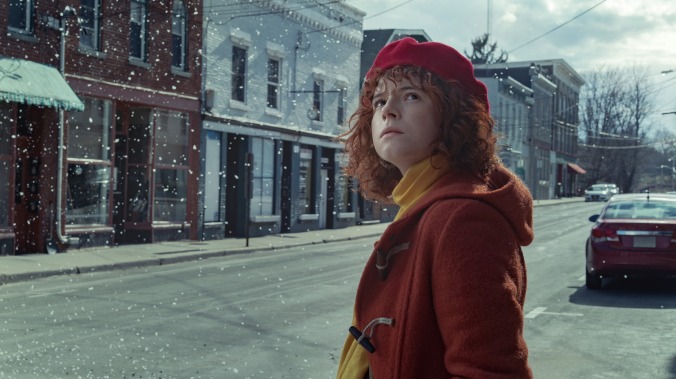Let’s talk about the ending of Charlie Kaufman’s new movie, I’m Thinking Of Ending Things


Spoiler Space offers thoughts on, and a place to discuss, the plot points we can’t disclose in our official reviews. Fair warning: This piece reveals major plot elements from both the movie version of I’m Thinking Of Ending Things and the Iain Reid novel on which it’s based. The endings of both will be revealed.
When Charlie Kaufman sets out to make a movie out of your book, you should prepare, at the bare minimum, for some deviations. Kaufman, after all, is the guy who took Susan Orlean’s The Orchid Thief—a nonfiction study of flower obsession—and inserted himself right into what passed for its story, transforming the whole thing into a neurotic-funny account of his struggles to adapt it. He does something entirely different but pretty radical in its own right with I’m Thinking Of Ending Things, the Iain Reid book that provides the source material for his latest film, which arrived on Netflix today. In some respects, it’s a faithful interpretation, preserving the plot structure, many of the themes, and even the ultimate “shocking” revelation that puts a bow on top of Reid’s disquieting narrative. But the tone of the movie is quite different, and once Kaufman reaches the story’s climax, he makes the unexpected choice to stay true to its ultimate meaning—to what’s really been going on the whole time—while simultaneously forgoing literal explanation. He takes a clean, familiar resolution and gives it the shape of maddening irresolution.
Slim enough to be read in one sitting (and to straddle the indeterminate page-count line that separates a novel from a novella), Reid’s version of I’m Thinking Of Ending Things is more easily classified and digested than Kaufman’s, though they share the same basic log line: A young woman (played, in the film, by Jessie Buckley) embarks on a road trip with her new boyfriend (Jesse Plemons) to meet his parents, even though she’s increasingly convinced the relationship isn’t going to last. On the page, it’s a psychological horror story, though it takes a few chapters for that to become clear—and even once it does, the book is more interested in sustaining a vaguely unnerving mood and zeroing in on upsetting details (a frightening childhood memory, a missing toenail, a stranger’s ominous warning) than laying on the overt scares.
I’m Thinking Of Ending Things is so effective as an exercise in mounting, irrational unease that this reader couldn’t help but feel a little disappointed when Reid finally brought it to a very rational conclusion, unveiling the secret he’d been dancing around for the entirety of the novel: that the young woman, our faithful narrator, is actually just a figment of some lonely janitor’s imagination. She doesn’t exist and neither does the boyfriend, at least not in this young form. Their road trip is at best a daydream, at worst a psychotic episode—a man’s fantasy of the romance he could have had if he had worked up the courage to talk to some random stranger at a bar years earlier.
Dissociative identity disorder is, by now, a rather hoary device. Kaufman knows that. He made a whole joke about it in Adaptation, in which his (fictional) twin brother, Donald, writes a screenplay whose characters—a serial killer, the woman he’s kidnapped, the cop on the case—all exist in the mind of the same deranged person. (The film mockingly floated this premise about four months before a Hollywood thriller I won’t name came out and played it completely straight.) Yet Kaufman doesn’t excise Reid’s twist. What he does instead is essentially abstract it. The book comes right out and says what’s going on during its suspenseful final stretch, when the young woman follows her boyfriend into his old high school, becomes convinced she’s being stalked by the janitor (a character we don’t meet until the end), and rudely awakens to the truth that she doesn’t really exist. In the movie, though, the arrival at the school triggers not an expository explanation but a complete dismantling of the film’s already fragile conception of reality: There’s a weirdly touching musical interlude, a cameo by a talking animated pig, and an absurdist stage-performance ending that makes no attempt to wrap up the plot. It’s as if Kaufman reached the moment in the book where Reid finally made clear sense of his story and decided to instead plunge it further into inconclusive surrealism.
Except that the explanation is still there. Kaufman just implies it, instead of saying it directly. There are numerous hints sprinkled throughout the film: the mysterious cutaways to the janitor character (Guy Boyd), going about his daily routine while the plot proper unfolds in parallel; the way details about the young woman, from her name to her job to her haircut, keep changing from scene to scene, sometimes even from frame to frame; how some of the young woman’s dialogue comes straight from books in her boyfriend’s childhood bedroom, including a poem she recites on the way to the farmhouse and a Pauline Kael review she parrots verbatim on the way back. The absolute funniest of these “clues” is basically the last one: a spot-on parody of the denouement of A Beautiful Mind (complete with bad old-age makeup and sweeping, prestige-drama score), a film that, of course, also featured an imaginary character that existed only in the protagonist’s mind. (If you wanted to go really out on a limb, you could even cite the casting of two actors with the same first name as a wink to the entwined nature of their lead roles.)
What’s brilliant about this approach is that it rescues I’m Thinking Of Ending Things from the deflating simplicity of its ending as written. Opting not to explicitly clarify what Reid inexorably built toward keeps the film open to multiple readings and interpretative trains of thought; it cannot be reduced to a mere puzzle waiting to be solved, or a glorified prelude to a twist ending audiences have seen many times before. And by often expressing the story’s big revelation through visual means—like the song-and-dance number he stages in the halls of the school, which this writer is choosing to see as a reference to An American In Paris, one of the ultimate examples of “resolving” a plot through pure spectacle—Kaufman finds a properly cinematic substitution for the window into the mind prose can provide. Meanwhile, fans of this one-of-a-kind filmmaker can take additional pleasure in the fact that he’s essentially made a serious, maybe even profound movie from a premise he once presented as a throwaway gag. Donald Kaufman is dead, but The Three lives on.